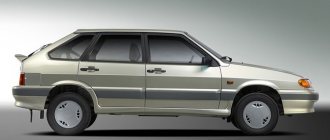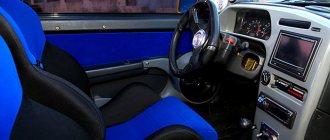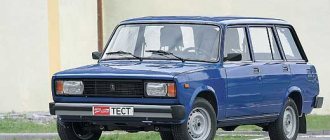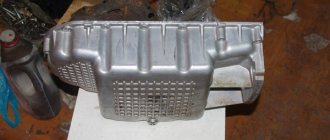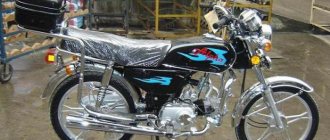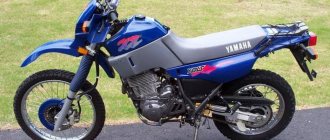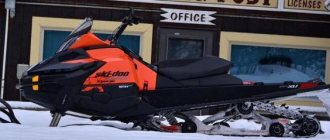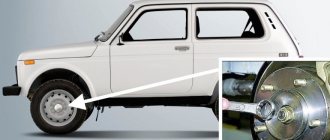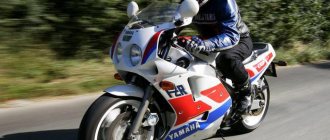Exterior
The appearance of the VAZ 2114 is not for everyone. Just like in the “ninth” family, “square body shapes” predominate here. A lot of broken lines completely deprived the car of grace, but added confidence and its own style to its appearance. The car has a large glass area, which provides the driver with good all-round visibility.
It is noteworthy that the VAZ 2114 is the only model of a domestic manufacturer whose door opening angle is 90 degrees. Agree, not every foreign car can boast of such convenience.
The front part of the “fourteenth” is expressed by large rectangular headlights, divided into two sections, a miniature radiator grille that provides the necessary volume of air to cool the power plant, and a neat bumper.
The wheel arches of the car look compact and appropriate: 13-inch wheels fit well into them. On later editions, the manufacturer provided 14-inch wheels.
Among the attractive exterior features are aggressive optics and short aerodynamic overhangs, which give the car good dynamic characteristics. The only inconvenience is the small side mirrors, which provide insufficient visibility to the driver. Special indignation is caused by door handles with a “tongue” that periodically does not allow the driver to enter the car.
The body of the fourteenth model consists of more than half of galvanized steel, the use of which was supposed to give the car anti-corrosion resistance. However, the hatchback did not receive this quality. As a result, drivers, in order to maintain the integrity of the car, have to periodically treat it with anticorrosive. Otherwise, through corrosion will very quickly render the vehicle unusable.
Interior
In the interior decoration of the fourteenth model, the designers miscalculated a little with the materials. For example, the fabric used for seat upholstery wore out after just a couple of years of active use, which is why drivers always had to use covers. The hard plastic used in the control panel begins to creak strongly in the cold, which causes some inconvenience to the car's passengers.
Torpedo Lada Samara (2114) 2001–13
There is no need to mention the sound insulation of the VAZ 2114 - there is practically none in the car. Meanwhile, the interior of the hatchback is compact and laconic. All control devices are located near the driver. The center console is even turned in his direction for convenience. In front of the front passenger there is only a glove box and a niche for small items.
The cabin capacity is four adults. And only of average height. It will be extremely uncomfortable for tall people in the back seat: firstly, the low ceiling will interfere, and secondly, there is too little distance between the rows of seats for knees.
The main convenience of this hatchback is the folding rear row of seats. By folding it, the driver will receive increased luggage space.
conclusions
The installation and repair of the front suspension of the VAZ-2114 is quite difficult and not every motorist can do it. This article examined the design and repair of the front suspension.
As you can see, there is a main group of parts that change when worn out and broken, and there are also a number of parts that are considered consumables and are replaced when the main components are repaired.
It is worth noting that suspension repair has a significant degree of danger, because the fall of one of the elements can lead to injury and even death. Therefore, when performing repair operations you must be extremely careful. Also, many suspension elements are quite heavy, so you need to have an assistant on hand.
My car is very dynamic, comfortable in the cabin. The exterior is very beautiful, as it has classic shapes without any biodesign. It's a shame that it's being discontinued. I am sure that this is not due to the obsolescence of the model. The world also knew cars that had been in production for much longer. Take the Niva or the Zhuk, for example. That’s why they say that it has become a competitor to Grants and Kalinas, with which all dealer sites in the country are filled to capacity. So I wrote a brief technical description of my car. I tried to be as similar as possible to a competent and clear expression of all the advantages. The Lada 2114 Super Auto is only superficially similar to the production car VAZ 2114. The Lada 2114 Super Auto has a 16-valve engine 21124 (the valves do not bend), fuel consumption in the urban cycle is 7 liters . The engine has an imported timing system, a lightweight cylinder-piston group, a MAN pump, the gas pedal has a cable drive, and a VALEO clutch with an increased disc diameter and increased pedal softness is installed. The leg doesn't get tired. Clutch service life is 150 thousand km. .The Lada 2114 Super Auto has a 2170 (Priora) gearbox. This gearbox is distinguished from serial ones by manual assembly, selection of gears, installation of sealed bearings. The gearbox on this vehicle is free from vibrations, hums and noise, the service life has been increased to 300 thousand km.
The gear shift system has short throws and clear detent. The car is equipped with reinforced (sports) type drives and CV joints using grenades from a German manufacturer.
The chassis on our car is installed entirely from the VAZ 2170 (PRIORA), which includes Priora front and rear struts, springs of variable stiffness, Priora support bearings, and a completely Priora rear beam. The front stabilizer has been increased in diameter from 1.5 to 2.2 mm.
A brace is installed between the front pillars, increasing torsional rigidity of the body.
As a result of using the Priora chassis, the ground clearance of this car increased by 7 cm compared to the usual 2114 and became equal to the Niva’s ground clearance.
The hubs are equipped with bearings from the Japanese manufacturer TOKIKO, the service life of which is 200 thousand km.
Due to the increase in engine power and maximum speed, the car received enhanced brakes and front ventilated brake discs.
In turn, with an increase in the diameter of the brake discs, 14th radius wheels are installed on the car. Tires have dimensions from 175/60/14 to 185/70/14.
The car's exhaust system received a catalyst manifold, which is installed in the engine compartment, and does not hang down almost half a meter like in conventional VAZ models.
The steering has a rack with a variable gear ratio, which greatly facilitates maneuvering in difficult urban conditions.
The cars are equipped with central locking on all doors, electric glass lifts, a third additional brake light, a rear wiper, a heater motor with increased airflow intensity (imported), mud flaps for all four wheels and dirt-proof plastic lockers, athermal glass, including the windshield (light tinted). blue color according to GOST).
Engine power 90 hp
Maximum speed 190 km/h
Fuel consumption is 5 liters per 100 km – highway, 7 liters / 100 km – city.
Fuel grade -95.
I hope I described everything clearly and understandably. I think that VAZ will regret more than once that the Fourteenth was discontinued from production. It was the most inexpensive and fashionable car. Thanks to everyone. Dmitry.
Engine modifications
Until 2007, the “fourteenth” model was produced with a 1.5-liter 8-valve gasoline engine producing 77 hp, which met Euro-2 requirements. In 2008, engineers installed a new control unit on the model, thereby increasing the environmental friendliness of the engine to the Euro-3 level. At the same time, 1.6-liter 8-valve units with 81 hp began to be installed in the car. The use of a new control unit entailed the need to replace the gas pedal: now an electronic system was used instead of a cable. The first batches of cars with an electronic gas pedal revealed many problems, which could only be resolved by the beginning of 2012.
Engine with a displacement of 1.6 liters.
Since 2008, engineers have slightly changed the design of the model: they moved the catalyst from under the bottom and installed it next to the power plant. This solution made it possible to protect the mechanism from damage when driving off-road by protecting the engine. In parallel with this, a new modification of the 1.6-liter engine with 16 valves and 89 hp was developed. power. The car received improved dynamic characteristics and 14-inch wheels.
It was possible to achieve Euro-4 environmental friendliness only in 2010, when Super-Auto CJSC prepared for production the “fourteenth” with an engine with a power of 98 hp, a volume of 1.6 liters and 16 valves.
In combination with all engines, a five-speed manual transmission was installed.
DIFFERENCES between VAZ and VAZ 2109
Since the fourteenth, in fact, is a modified version of the nine, it is necessary to understand what the main difference between the VAZ 2109 and the VAZ 2114 is.
Let's go through the most significant points.
- Body
In terms of dimensions, the fourteenth differs slightly from the nine - it is 10 centimeters longer and 40 kg heavier. The ground clearance and wheelbase have not undergone any changes.
The differences in the body are quite significant - the presence of a new hood, headlights, radiator, bumpers and moldings create the impression of a completely new car. If we talk about the quality of the metal, then things are much better in the fourteenth model - with proper care, it does not rot even in the most problematic places.
- Engine and suspension
The base model of the VAZ 2114 was equipped with an 8-valve 1500 cm3 engine, similar to the one on the Nine, but in 2007 models with a 1.6-liter engine that complied with the Euro-4 standard with an electronic gas pedal and an electric throttle began to roll off the assembly line.
In 2010, the “Super-Auto” modification went on sale with a 16-valve power unit, which is superior to the Nine engine in all respects.
The chassis of the fourteenth, in comparison with the VAZ 2109, did not undergo any serious design changes.
- Salon
The interior is one of the key advantages of the fourteenth in comparison with the VAZ 2109. The first thing that stands out (thanks to the use of hard plastic), whereas in the nineth, this was one of the main problems.
Specially invited foreign designers worked on creating the interior of the cabin, so it is visually comparable to the interior of middle-class foreign cars of the same year of manufacture.
Unlike the Nine, the interior of the VAZ 2114 is distinguished by softer shapes and the presence of various little things - power windows, new seats, illuminated ashtrays, which significantly improve the comfort of both the driver and front passenger.
The functionality of the interior has also improved significantly - the instrument panel is equipped with an on-board computer, which informs the driver about the status of the main vehicle systems, ambient temperature, current time and has many useful functions.
2114 and 2109
Options
The basic equipment of the VAZ 2114 cannot boast of wealth, however, it has everything that is so necessary for daily movement:
- height-adjustable steering column,
- the presence of an on-board computer informing about the remaining gasoline in the tank, average fuel consumption and power reserve,
- electric windows for front doors,
- inertia seat belts,
- full size spare wheel.
In the “Standard” configuration, an interior lamp, a mirror in the passenger visor and a combined steering wheel upholstery were added to the car’s equipment. In the maximum configuration, the car received fog lights, heated front seats, and adjustable headrests in the rear row.
On-board computer VAZ 2114
The luxury package was also complemented by 14-inch stamped wheels. The VAZ 2114 never had airbags, ABS and ESP systems, so this car cannot be called safe.
Specifications
The technical characteristics of the car are presented in the table below:
| Options | Index |
| Length, mm | 4 122 |
| Width, mm | 1 650 |
| Height, mm | 1 402 |
| Ground clearance, mm | 160/165 |
| Front track width, mm | 1 400 |
| Rear track width, mm | 1 370 |
| Wheelbase, mm | 2 460 |
| Trunk volume, l | 330/600 |
| Weight, kg | 985 |
| Fuel tank volume, l | 43 |
| Load capacity, kg | 425 |
From 2001 to 2010, the car was produced with a ground clearance of 160 mm, but after modifications by Super-Auto JSC, the figure increased by 5 mm. One of the main advantages of the model is the ability to increase the luggage compartment from 330 to 600 liters, thanks to the folding rear seats.
Auto-reactor
Samara-2 family appeared in 1997 as a further development of the popular front-wheel drive Samara ( Sputnik ) family. The first-born of the restyled family was the VAZ-2115 , which is actually a restyled version of the VAZ-21099 . Its exterior was “rejuvenated” due to new wings, hood and bumpers, as well as lighting equipment of a different shape, the trunk received a new lid with an opening to the bumper, but the central part of the body (salon) with doors was left unchanged. The capacity of the luggage compartment has increased from 365 to 427 liters in comparison with the “ninety-ninth” model. A plastic protective belt appeared along the lower perimeter of the body, and the sills were covered with aerodynamically shaped plastic overlays. The front wheel arches were equipped with practical arch extensions that prevent splashing on the sides of the body. A new instrument panel (popularly called the “European panel”) made of polypropylene facing the driver was installed on the “15th”. On it, in the “luxury” version, a set of warning lamps appeared for low levels of oil, coolant and washer fluid, wear of brake pads for locking doors and seat belts, a key left in the ignition, etc. A heater of an improved design also appeared. In general, the entire package of improvements made it possible to rename the modernized family “ Samara-2 ”.
Starting with the VAZ-2110 , each new model at VAZ is mastered in several stages: first, it is assembled in pilot production in small batches (using bypass technologies), its production volumes are gradually increased, and only then it is transferred to the main factory conveyor. The “15th” model went through the same procedure. Only in 2000 did it join the main conveyor belt of VAZ , and in the summer of 2004 it finally replaced the “099th” predecessor, whose production was transferred to the Ukrainian LuAZ. It is interesting that while the coexistence of two technically identical models lasted (unique for Western manufacturers), each of them had its own adherents.
The second model of the Samara-2 in 2000 was the five-door hatchback VAZ-2114 , created on the basis of the VAZ-21093 with an equipment package similar to the sedan. Unfortunately, the plant did not have enough funds to develop a new rear door, which, like the trunk lid on a sedan, should have reached the bumper (the lights would have been unified), so the rear of the “14th” body remained virtually unchanged. This does not interfere with the popularity of the model, which since the spring of 2004 has completely ousted the “nine” from production. VAZ-2113 model , created to replace the G8, appeared in production only in the fall of 2004.
The main engine for the Samara-2 gradually became the 8-valve 1.5-liter VAZ-2111 with a distributed injection system, although the first batches of the VAZ-2115 were equipped primarily with the “21083” carburetor engine, but with the 16-valve “2112” " Samara-2 " was never officially staged. In addition, in 1999-2002. In the OPP, version 2115-91 “Rotor” with a two-section VAZ-415 rotary piston engine was assembled to order piece by piece.
Possible malfunctions Engine :
- Failures and malfunctions of the GM injection system.
- Weak factory tightening of nuts and bolts of the transmission, engine and chassis. Alternator belt wear (50 thousand km).
- Wear of parts and components of the cooling system. Frequently change the oil filter.
- Poor engine mount design—destruction of the lower cross member of the engine compartment. Unreliability of Solex-type carburetors, especially EPHH.
Transmission:
- Failure of the gearbox drive shaft (models produced in late 1999 - early 2000 with a mileage of up to 50 thousand km).
- Wear of clutch discs on the “21083” engine (20-30 thousand km). Increased noise and play in the gear lever.
Chassis:
- Broken wheel alignment. Uneven brake force.
- Wear of silent blocks and loosening of suspension fastenings. Failures of the vacuum brake booster.
Electrical equipment:
- Electronics failures on the control panel.
- Poor quality connection of electrical wiring to terminals.
- Failures of electronic components (switch) of the ignition system of carburetor engines. Failures in the operation of the sound signal.
- Starter failures.
- Windshield wiper failures.
- Electric heater fan failures.
Body:
- Rough finish and large gaps in body and interior panels.
- Dirt accumulates under the overhead fender and sill extensions, leading to corrosion. Corrosion of mud flaps near the front suspension struts.
- Wheel arch corrosion.
- Corrosion of the A-pillars at the base. Radiator Frame Corrosion
- Leaf clogging of the ventilation system. Weak front seat frame.
Country of manufacture: Russia (Togliatti) Body: monocoque Body type: hatchback/sedan Number of doors: 3/ 4/ 5 Number of seats: 5 Drive type: front-wheel drive, engine in front transversely Suspension design: front McPherson strut, rear semi-independent on trailing arms Overall dimensions , mm 2113/ 2114: 4010x1650x1402 Overall dimensions, mm 2115: 4330x1650x1420 Wheelbase, mm: 2460 Ground clearance, mm: 160 Luggage compartment volume, l 2115: 390 Luggage compartment volume, l 2113/ 2114: 340/95 0 Curb weight, kg: 950-1095 Transmission: manual, 5-speed Tires: 175/70 R13
Production chronology 1997 - Start of production of the VAZ-2115 2001 - Start of production of the VAZ-2114 (small-scale) October 2004 - Serial production of the VAZ-2113
Modification of VAZ-2115 Engine type/number of valves* BV/ 4R/ 8 Displacement, l 1499 Power, hp 71 Maximum torque, N•m 118 Maximum speed, km/h 156 Acceleration to 100 km/h, s 12.2 Fuel consumption. 90 km/h/ GC, l 6.2/ 9.7
Modification of VAZ-2114 Engine type/number of valves* BV/ 4R/ 8 Displacement, l 1499 Power, hp 71 Maximum torque, N•m 118 Maximum speed, km/h 158 Acceleration to 100 km/h, s 12.0 Fuel consumption. 90 km/h/GC, l 6.1/ 9.5
Modification of VAZ-2113 Engine type/number of valves* BV/ 4R/ 8 Displacement, l 1499 Power, hp 71 Maximum torque, N•m 118 Maximum speed, km/h 160 Acceleration to 100 km/h, s 11.8 Fuel consumption. 90 km/h/ GC, l 6.0/ 9.5
* BV - gasoline, injection; BVT - gasoline, injection, turbocharging; BC - gasoline, carburetor; D - diesel; DNV - diesel with direct injection; DT - diesel, turbocharged; DNVT - diesel with direct injection, turbocharging; RPD - rotary piston Wankel engine.
The entry was published on November 28, 2008 at 09:53 pm and posted in the VAZ section, VAZ History. You can read comments using the RSS feed. The discussion is closed, but you can send a trackback from your site.
Controllability
The car's handling is difficult to call ideal. Yes, it takes turns, confidently accelerates, but at the same time it has a noticeable play when turning the steering wheel, which is several times higher than the permissible values. The “fourteenth” has an independent spring suspension at the front, and a semi-independent spring at the rear.
Being a car passenger also has a hard time - due to the stiff suspension, all road irregularities are felt in the cabin. You won’t be able to drive the “fourteenth” off-road either – any “diagonal” will take the driver by surprise. This car is designed for city and highway travel.
Competitors
The VAZ 2114 has had many competitors at all times, and many drivers were amazed: why, with such a variety of foreign analogues, many car enthusiasts prefer the domestic “designer”. It's simple: getting spare parts for foreign cars was often problematic. You can repair a VAZ using improvised means. However, among the competitive models, several cars should be highlighted. The first of them is the Chevrolet Lacetti. This nimble and attractive car has excellent dynamic characteristics, great endurance and rich technical equipment. Its design, developed by the Italian studio Pininfarina in 2002, is still relevant today. The car, discontinued in 2014, is still in high demand on the secondary market.
Chevrolet Lacetti
The Opel Corsa is another compact car, famous for its high engine life and excellent handling. From the outside it seems that the Corsa is cramped and uncomfortable, but when you look into the interior, you are pleasantly surprised - everything here is laconic and thoughtful. The history of the Opel Corsa began in 1982 and continues to this day. In the line of its generations one can trace the history of improving engineering. The manufacturer switched from broken lines to exaggerated futuristic design back in 2000, a year later AvtoVAZ released the “square fourteenth”. In 2006, an updated version of the Corsa was born - with huge headlights, stylish moldings in the front part and an elegant body bevel. In the VAZ 2114, in addition to engine modifications, there were no more significant changes until the end of production.
AvtoVAZ in the 2000s and later
Since the 2000s, sales of VAZ cars have been sharply declining due to the opening of foreign concerns that offered consumers more reliable and modern cars at relatively affordable prices. The management team again decides to update the model range. All subsequent cars did not gain popularity among potential consumers. The only exception is the VAZ-2114, which is still considered by many to be almost the best vehicle in the entire history of AvtoVAZ.
What is unique about the VAZ-2114? Fully focused on European quality. In addition, in this car:
- a European-style dashboard was installed;
- moldings were used;
- The design was radically redesigned, although the base remained from Samara-2, the appearance became more aggressive.
Then the VAZ-2114 was replaced by 2115, but in fact they differed little from each other. There were drastic changes in 2116, but this car never appeared in serial sales. It was only demonstrated at an exhibition in 2005, after which the developed concept migrated to those cars that were already produced under the auspices of Renault.
We can safely say that the VAZ-2115 is the last vehicle produced by AvtoVAZ as it was back in the days of the Soviet Union.
After that, in 2013, the concern’s shares were bought by Renault and Nissan, and the model range was radically redesigned. The focus was on Kalina and Priora, which, despite harsh criticism, gained wide popularity. Now the company is developing and producing a new generation Kalina, including the Sport modification, and just a year ago the Lada Vesta was introduced. It is worth noting: these cars no longer have the VAZ prefix in their names.
Advantages and disadvantages
It is advisable to include all the advantages and disadvantages of the model in the table.
| Advantages | Flaws |
| Automotive stores almost always have spare parts for the VAZ 2114 in stock, so the car can be repaired in the shortest possible time. | Lack of airbags and additional options to save the lives of the driver and passengers in the event of an accident |
| Due to its light weight, the “fourteenth” accelerates quickly and consumes a small amount of fuel mixture | Weak head optics provide poor visibility at night, fog and snowfall |
| Thanks to the expanding luggage compartment, a large amount of cargo can be transported inside the car | Low quality metal leads to rapid rotting of the car |
| With proper care of the machine, it functions properly in both extreme heat and severe frost. | No blocking, low cross-country ability on off-road and snow |
| Thanks to its small dimensions, it is very convenient to “check” the VAZ 2114 in city traffic jams | A cramped interior with a low ceiling, designed for only four people of average height |
| Large glass area provides good visibility on the road | A large number of problems with engines for models of any year of manufacture |
Reviews from car owners
Reviews from car owners will help you make a complete conclusion about the car’s reliability.
“I purchased a VAZ 2114 in 2004. By those standards, the car was fresh and stylish. But somehow it grew old too quickly: in the second year of operation, the engine liners were wrapped. Invested there. Then the exhaust pipe burned out. Replaced. Then the door handles began to break. This is generally the weak point of this unit. In winter, snow freezes under the tongue - until you push it off, you won’t get into the car. In summer, this tongue falls inside the handle, which also prevents access to the interior. I suffered a lot and invested a lot of money in the car. Finished off by the appearance of through rust in the bottom of the car. I always kept it clean, kept it in the garage, and did not go off-road. And here is the result: corrosion. I sold the “fourteenth” 5 years after the purchase and now I don’t even want to look in their direction. A real designer."
Yaroslav, Orenburg
“For me, the “fourteenth” is a real workhorse. For more than ten years now I have been making money from it: I take vegetables to the nearest city to sell. Because All spare parts for the car are inexpensive, repairs allow you to save money. It is roomy, easy to control, and starts reliably in cold weather. I have a basic configuration and the simplest engine - 1.5 liters. It is not a pity to use it to its fullest extent, and so far it copes with its tasks quite easily. A couple of years ago I only noticed that the body began to rot. I took it to a service center, painted it, and now the car looks like new. There were problems with the engine, but I fixed them myself.”
Pavel, s. Yantishevo
“I have no confidence in this car. My son bought it not long ago. The copy seems to be fresh - 2011, but inside it is like being in a tank. The engine is very loud, the suspension rattles, and there seems to be no sound insulation at all. It is unsafe to drive such a car - it will fall apart at any moment. He bought a car to work as a taxi, but he already invested more into it than he earned. And he’s even a little ashamed to transport passengers in this “domestic carriage”. Now the fourteenth one is in the garage - its starter has once again failed. Selling such a car further is a real crime. The only way out is to sell it for scrap.”
Inna, Tyumen
“I’ve been driving a 2010 VAZ 2114 with a 1.6 engine for four years now. I actively use the car and am amazed at how durable it is. Yes, there were problems with the power plant, but they were all easily resolved. On the fourteenth, my family and I go to nature, visit relatives 300 km away, and it always functions properly. On light off-road conditions, the car obeys the steering wheel and does not slip. It also handles quite confidently on a snowy track. There have been times when I got stuck in the winter, but this problem is common to all front-wheel drive cars. The only significant shortcomings of this machine are in the electrics. In severe frost, the rear lights periodically stopped working. I had to tinker with the wiring, rewind the wires and now the optics work properly. I recommend the car to those who like a quiet, measured ride and are not afraid to repair the car themselves.”
Andrey, Ekaterinburg
Video test drive
| VAZ-2114 (LADA Samara) - a five-door hatchback from the Volzhsky Automobile Plant, a restyled version of the VAZ-2109, a continuation of the family under the code name “Samara-2”. The model differed from its predecessors in the original design of the front part of the body with new headlights, hood, radiator trim, bumpers and the presence of moldings. Presented to the public in 2001, serial production - from April 2003 to December 2013 [1]. The interior of the VAZ-2114 was equipped with a new instrument panel (the so-called “European panel”), an adjustable steering column, a steering wheel from the “tenth” family, a new heater design, and front power windows. The car was equipped with a 1.5-liter eight-valve engine (VAZ-2111) with distributed fuel injection. |
Summarize
LADA Samara was popular in the early 2000s due to its low cost, maintainability and novelty. They bought it because... It was difficult to find a foreign analogue in good condition. However, now there are no problems with competitors - they are all available in abundance on the secondary market. It’s hard to say what makes car enthusiasts buy domestic “fourteeners”. Possibly savings. Perhaps a desire to support AvtoVAZ.
However, in any case, when purchasing this car, it is worth remembering that it is no different in safety and reliability. And it is better to give preference to foreign competitors in which manufacturers have invested at least minimal options to ensure safe movement. Especially if you plan to use the vehicle to transport passengers. Savings are not appropriate here.
